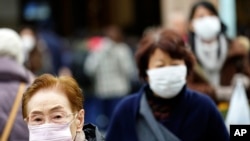A second person has died from a newly identified virus in central China that has sickened dozens. The outbreak prompted U.S. health officials to announce Friday that the United States would begin screening airline passengers arriving from central China. Here is what we know about the virus.
What is the newly identified virus?
Health authorities have identified the virus as a new type of coronavirus, part of a large family of viruses that includes the common cold as well as the more serious illness SARS. Laboratory tests have ruled out all previously known coronaviruses, including SARS, or severe acute respiratory syndrome, MERS, or Middle East respiratory syndrome, as well as influenza and bird flu. Scientists say the new virus strain appears most similar to SARS, but say it seems to be weaker than that disease.
How many people have become sick?
Two people in China have died from the mysterious virus and 41 others have been infected. Chinese officials say five people are in serious condition.
Where has the disease been reported?
Cases of the virus were first reported in the central Chinese city of Wuhan, believed to be the epicenter of the outbreak. Chinese health officials say many of those who became sick worked at or visited a seafood market in the suburbs of Wuhan. Three cases have been detected outside China — two in Thailand and one in Japan — but health officials say those patients had visited Wuhan before becoming sick.
How does the virus spread?
Health officials believe the virus is spread from animals to humans. There is, so far, no evidence that the virus is capable of human-to-human transmission, although health officials say they cannot rule out this possibility. Scientists say it is also possible that the virus could mutate to become more dangerous.
What are the virus symptoms?
The most common symptoms of the virus are fever, cough and difficulty breathing.
What is the U.S. response?
The U.S. Centers for Disease Control and Prevention said the risk of the virus to the American public is low, but that it wants to be prepared and so is setting up health screenings at three U.S. airports. The focus will be on travelers to the United States on direct or connecting fights from Wuhan. The CDC said travelers with symptoms arriving at San Francisco, New York and Los Angeles airports will undergo testing for flu or other possible causes.
How are Asian countries responding?
At least a half-dozen countries in Asia have also started health screenings for incoming airline passengers from central China, including Thailand and Japan, both of which have seen cases of the virus. This time of year is one of the busiest travel seasons in China, with people flying both to and from the country to celebrate the Lunar New Year. China has increased disinfection efforts in major transportation hubs.
What is the World Health Organization recommending?
The WHO is warning that a wider outbreak of the virus is possible and has given guidance to hospitals worldwide. It said in a statement Thursday that it did not recommend instituting any trade or travel restrictions on China at this time.









